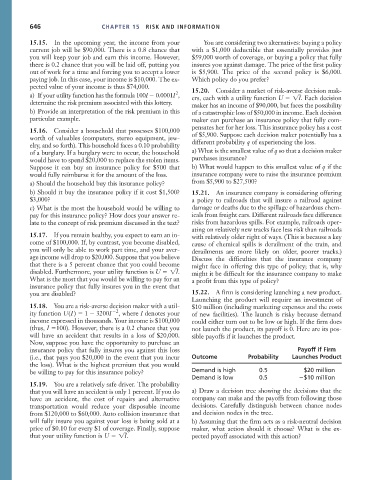Page 672 - Microeconomics, Fourth Edition
P. 672
c15riskandinformation.qxd 8/16/10 11:10 AM Page 646
646 CHAPTER 15 RISK AND INFORMATION
15.15. In the upcoming year, the income from your You are considering two alternatives: buying a policy
current job will be $90,000. There is a 0.8 chance that with a $1,000 deductible that essentially provides just
you will keep your job and earn this income. However, $59,000 worth of coverage, or buying a policy that fully
there is 0.2 chance that you will be laid off, putting you insures you against damage. The price of the first policy
out of work for a time and forcing you to accept a lower is $5,900. The price of the second policy is $6,000.
paying job. In this case, your income is $10,000. The ex- Which policy do you prefer?
pected value of your income is thus $74,000. 15.20. Consider a market of risk-averse decision mak-
2
a) If your utility function has the formula 100I 0.0001I , ers, each with a utility function U 1I. Each decision
determine the risk premium associated with this lottery. maker has an income of $90,000, but faces the possibility
b) Provide an interpretation of the risk premium in this of a catastrophic loss of $50,000 in income. Each decision
particular example. maker can purchase an insurance policy that fully com-
pensates her for her loss. This insurance policy has a cost
15.16. Consider a household that possesses $100,000
worth of valuables (computers, stereo equipment, jew- of $5,900. Suppose each decision maker potentially has a
elry, and so forth). This household faces a 0.10 probability different probability q of experiencing the loss.
of a burglary. If a burglary were to occur, the household a) What is the smallest value of q so that a decision maker
would have to spend $20,000 to replace the stolen items. purchases insurance?
Suppose it can buy an insurance policy for $500 that b) What would happen to this smallest value of q if the
would fully reimburse it for the amount of the loss. insurance company were to raise the insurance premium
a) Should the household buy this insurance policy? from $5,900 to $27,500?
b) Should it buy the insurance policy if it cost $1,500? 15.21. An insurance company is considering offering
$3,000? a policy to railroads that will insure a railroad against
c) What is the most the household would be willing to damage or deaths due to the spillage of hazardous chem-
pay for this insurance policy? How does your answer re- icals from freight cars. Different railroads face difference
late to the concept of risk premium discussed in the text? risks from hazardous spills. For example, railroads oper-
ating on relatively new tracks face less risk than railroads
15.17. If you remain healthy, you expect to earn an in- with relatively older right of ways. (This is because a key
come of $100,000. If, by contrast, you become disabled, cause of chemical spills is derailment of the train, and
you will only be able to work part time, and your aver- derailments are more likely on older, poorer tracks.)
age income will drop to $20,000. Suppose that you believe Discuss the difficulties that the insurance company
that there is a 5 percent chance that you could become might face in offering this type of policy; that is, why
disabled. Furthermore, your utility function is U 1I. might it be difficult for the insurance company to make
What is the most that you would be willing to pay for an a profit from this type of policy?
insurance policy that fully insures you in the event that
you are disabled? 15.22. A firm is considering launching a new product.
Launching the product will require an investment of
15.18. You are a risk-averse decision maker with a util- $10 million (including marketing expenses and the costs
ity function U(I ) 1 3 200I 2 , where I denotes your of new facilities). The launch is risky because demand
income expressed in thousands. Your income is $100,000 could either turn out to be low or high. If the firm does
(thus, I 100). However, there is a 0.2 chance that you not launch the product, its payoff is 0. Here are its pos-
will have an accident that results in a loss of $20,000. sible payoffs if it launches the product.
Now, suppose you have the opportunity to purchase an
insurance policy that fully insures you against this loss Payoff if Firm
(i.e., that pays you $20,000 in the event that you incur Outcome Probability Launches Product
the loss). What is the highest premium that you would
be willing to pay for this insurance policy? Demand is high 0.5 $20 million
Demand is low 0.5 $10 million
15.19. You are a relatively safe driver. The probability
that you will have an accident is only 1 percent. If you do a) Draw a decision tree showing the decisions that the
have an accident, the cost of repairs and alternative company can make and the payoffs from following those
transportation would reduce your disposable income decisions. Carefully distinguish between chance nodes
from $120,000 to $60,000. Auto collision insurance that and decision nodes in the tree.
will fully insure you against your loss is being sold at a b) Assuming that the firm acts as a risk-neutral decision
price of $0.10 for every $1 of coverage. Finally, suppose maker, what action should it choose? What is the ex-
that your utility function is U 1I. pected payoff associated with this action?

